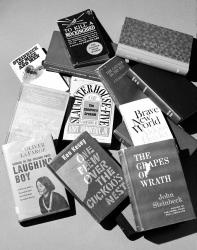We welcome your reviews of books that • were published within the past three years • do not advocate for a political party or politician • do address issues supported by the League, and • intrigued you enough that you want to share them. Please submit your review at any time to Margan and Thad Zajdowicz (Margan.Zajdowicz [at] gmail.com ()).

When I was six years old, my parents went to Europe for three months, leaving me in the tender care of my beloved grandmother. When they returned, each parent brought back treasures: My mother brought back a trunk full of Danish wooden toys and Swiss dolls, along with a wooden crate that contained an exquisite German human skull that was perfectly articulated for study with tiny brass fittings. My father brought back two banned books—unexpurgated copies of Henry Miller’s Tropic of Cancer and Tropic of Capricorn.
Those contraband copies of Miller’s novels sat in our family library among the many volumes of British, French, and American literature, every book Bertrand Russell ever wrote, and innumerable tomes on the philosophies of Baruch Spinoza and George Santayana. Other spicy and intermittently banned books I discovered while prowling through the library included Vladimir Nabokov’s Lolita, Erskine Caldwell’s God’s Little Acre, D. H. Lawrence’s Lady Chatterley’s Lover, and Havelock Ellis’s The Psychology of Sex. Of course, I read all of them.
True to form, when the McMinn County (Tennessee) School Board tried to ban cartoonist Art Spiegelman’s graphic novel Maus—winner of the 1992 Pulitzer Prize for its daring and brilliance in chronicling the Holocaust and its legacy—I realized that I had never read this book, so I ran (metaphorically) right out and bought it from Amazon, where it had skyrocketed to the top of the bestseller charts. That’s what humans should do: They should go tearing after the latest banned book to see just what it is that other people don’t want them to know. I never can figure out why people who are into banning books (and ideas) don’t realize that the very attempt to curtail the dissemination of knowledge and ideas incites insatiable curiosity and makes those ideas and volumes all the more attractive.
Throughout history, innumerable attempts have been made to control ideas and people’s thoughts and exposures. In 259 BCE, the Chinese emperor Shihuangdi tried to bury 450 Confucian scholars in an effort to control the writing of history. In 212 BCE, he burned all the books in his kingdom in order to establish that history began with him. Some efforts to ban works have stretched from antiquity to modern times; Ovid’s Ars Amatoria (The Art of Love) was banned in 8 CE, burned in Florence in 1497, and banned by U.S. Customs in 1928.
Examination of the history of banned books reveals common themes that seem to spasmodically motivate people to censor, ban, or burn books. Ideas about race, gender, sexuality, religious views, Satan and witchcraft, perceived immorality, and subversion all attract attempts to censor and ban. Books containing profanity, disturbing events, and violence become targets. The most frequently banned books in the United States between 2000 and 2009, according to the American Library Association (ALA), were those in the Harry Potter series. Mark Twain’s Adventures of Huckleberry Finn and Ralph Ellison’s Invisible Man have been on banned book lists for decades for their frank explorations of racism. More recently, Margaret Atwood’s The Handmaid’s Tale has become a focus of those who would censor its portrayal of sexual explicitness and violence against women. Every year, the ALA publishes a Top 10 Most Challenged Books List, which includes the reasons these books are considered offensive. You’d be amazed at the classics that appear there.
The First Amendment allows all individuals to speak and read what they wish and has been interpreted legally as prohibiting censorship of books, articles, films, magazines, art, and other forms of human expression. The First Amendment protects the right to three freedoms: freedom of expression, freedom of belief, and freedom of peaceable assembly. It prohibits public institutions from interfering with the exercise of these freedoms.
Authoritarian regimes have notoriously used censorship and banning of books to control populations. Azar Nafisi, the author of Reading Lolita in Tehran, reminds us of how frequently this is done by the Islamic Republic of Iran. She never thought that similar events would occur in her new democratic home, the United States of America. In February 2022, Pastor Greg Locke of the Global Vision Bible Church of Mt. Juliet, Tennessee, held a book-burning event where copies of the Harry Potter and the Twilight series were tossed into the flames. Many drew a disquieting analogy between this event and the 1933 book burnings in Nazi Germany.
As Dr. Nafisi reminds us, thankfully we don’t live in a totalitarian state. However, totalitarian impulses have emerged in our highly polarized environment, and with these impulses has come a desire to control what people read and what they think. To quote Nafisi, “Books are a threat to those who seek to rule through absolutism.”
We would do well to pay attention to these attempts to ban, censor, and burn books. They are neither benign nor inconsequential events. When a book is threatened with banning, buy it, read it, and find out what it is that some people don’t want you to know or think about.
—Margan Zajdowicz, Co-editor, Book Corner

Just a few of the classics that have been on banned book lists for years. (Courtesy Library of Congress)